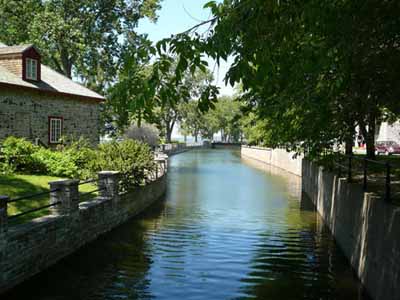Lachine Canal National Historic Site of Canada
Montréal, Quebec

General view
© Agence Parcs Canada/ Parks Canada Agency, 2007.
Address :
711 Saint-Joseph Boulevard, Lachine, Montréal, Quebec
Recognition Statute:
Historic Sites and Monuments Act (R.S.C., 1985, c. H-4)
Designation Date:
1929-05-17
Dates:
-
1821 to 1825
(Construction)
-
1821 to 1978
(Significant)
Other Name(s):
-
Lachine Canal
(Designation Name)
Research Report Number:
JUN 96-SUB; 1987-A03-4
DFRP Number:
06959 00
Plaque(s)
Existing plaque: On Monk Island 711 Saint -Joseph Boulevard, Montréal, Quebec
A harbinger of the Canadian transportation revolution of the 19th century and a symbol of the aspirations of Montreal merchants to establish commercial hegemony over the continental interior, the Lachine Canal, which extended from the port of Montreal to Lake St. Louis, was opened in 1824 and enlarged between 1843-48 and 1873-84. In addition to bypassing the Lachine rapids, the canal provided abundant water power, and along with other canals on the St. Lawrence system contributed to Montreal's rise as a great industrial and commercial centre. The canal was closed in 1971, 12 years after the opening of the St. Lawrence Seaway.
Description of Historic Place
Lachine Canal National Historic Site of Canada is an early 19th-century canal, 14 kilometres in length, built to circumvent five kilometres of white water on the St. Lawrence River between Lachine and the old port on Montréal Island, at the level of McGill street. It is now a recreational waterway running through the south-central part of the city of Montréal. Official recognition refers to the 14 km length of the canal and the property that is administered by Parks Canada.
Heritage Value
The Lachine Canal was designated a National Historic Site of Canada in 1929 because: in the 19th and 20th centuries, it played a role as the head of a canal network linking the heart of the continent to the Atlantic Ocean through the Great Lakes and St. Lawrence route; predating the revolution of transportation at the beginning of the 19th century and associated with the first tentative attempts at canal building in the French Regime, the Lachine Canal also played a role in determining the industrial and commercial development of Montréal as, among other things, a centre for the source of hydraulic power; the industrial corridor of the Lachine Canal is witness to different stages of the industrialization of the country and the manufacturing production that existed on its banks was exceptionally diverse. For that reason, it was one of the principal manufacturing centres in Canada from the beginning of the industrial revolution in the middle of the 19th century to the Second World War.
The heritage value of the Lachine Canal lies in the layout of the canal and the illustration of its historic role in the development of the country and of the city of Montréal. The Lachine Canal was built as a commercial canal in 1825-26 and was operated and upgraded continually as a commercial and industrial route until it was transferred to Parks Canada in 1978 for tourism development.
Sources: Historic Sites and Monuments Board of Canada, Minutes, 1987, 1996; Commemorative Integrity Statement, 1997.
Character-Defining Elements
The key elements that contribute to the heritage character of this site include: the route of the canal bed and its footprint; its location in the heart of the city; its setting, lined on each side by maritime, railway, road and energy corridors and former industrial buildings; the vestiges of earlier periods of canal construction and operations as evidence of the technology and engineering associated with construction and operations of the canal over time; the location, distribution, interrelationship, form and fabric of buildings and structures associated with the maintenance and operations of the canal over time; the spatial inter-relationships between the canal and the industrial and commercial sectors influenced by the presence of the waterway such as the Lachine Sector, the Rockfield Sector, the former City of Saint-Pierre/LaSalle Sector, the Saint-Henri/Côte Saint-Paul Sector, the Pointe Saint-Charles/Petite-Bourgogne Sector, and the Old Port of Montréal Sector; the viewscapes from the canal to resources associated with its historical role as a transportation and transshipment centre, in particular, the warehouses, wharfs, jetties, railway connections, railway and truck bridges, tunnels and similar structures associated with transshipment activities; the viewscapes from the canal to resources associated with the power generation, in particular, hydraulic canals, pylons and electrical lines.